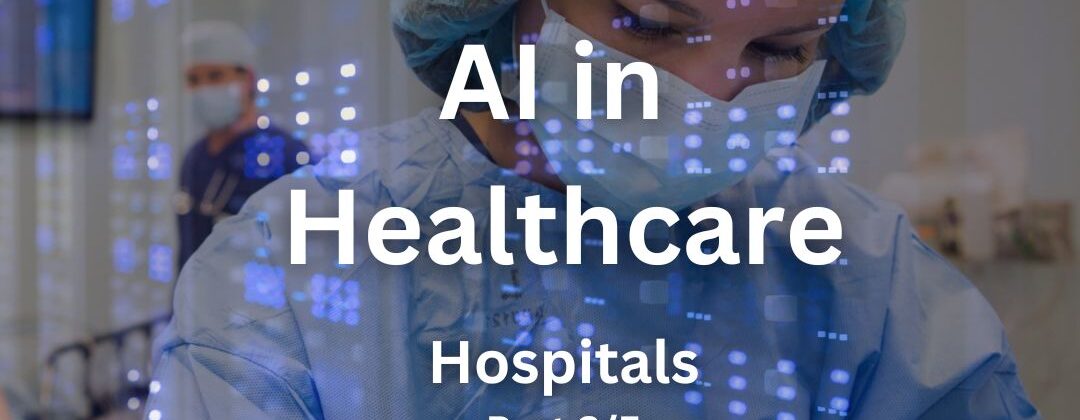
AI is changing how hospitals operate and will drastically change it moving forward. In Part 3, I’ll provide an overview of how AI is being used in the operations of hospitals to increase availability, reduce costs, and provide better care for the population in their community.
Running a hospital is a complex set of operations, no pun intended, processes, regulations, licensing, people management, and patients. Early in my career, a management consulting partner said there was not much difference between manufacturing and hospitals; the processes are just different. The word clueless came to mind almost instantly. The BIG difference is that humans are the focus of the processes, not pieces or parts. Add in licenses for just about everyone in the field, outside certification agencies, and a staggering number of regulations and you have an industry like no other.
Everything is focused on getting the patient better and as close to good health as possible. It’s a highly complex business that only some have a complete picture of how it all works together, and sometimes doesn’t, to heal people. I’ve come close but still only have a tiny understanding of everything.
A Quick Overview
First, for those not familiar with the operations of a hospital, I’ll spend a (very) short time trying to explain what happens beyond seeing the doctor, surgeon, or therapist. We’ll start with the administrative functions. These functions include what most companies do in strategy, business development, marketing, hiring, IT, legal, and facilities. Except for the last three, they have similar functions but are still highly regulated by governments.
The IT function is different as it has to maintain devices, such as computers, laptops, mobile, and medical devices like infusion pumps. For good reasons, they have many procedures and documentation that go along with anything done to the device.
The primary function of the IT group is maintaining the Electronic Medical/Health Record (EMR). This involves running the system, or platform, and providing staff and executives with analytics about the operations and patients a portal into the EMR. It always has to be up-to-date and available to clinical staff. It’s why hospitals almost always shut down during a ransomware attack; you don’t want to be giving a patient something they’re allergic to or administering a wrong dosage. Yes, there are ways around it, but it involves a lot of paper.
In Part 2, I discussed where recommendations can be provided to physicians by scanning across patient records, internal and anonymized external records, for an understanding of new or better treatment that a patient may be facing. This allows clinical staff to see what others in their field are doing and the latest research on a topic. AI is at the forefront of expanding this across almost all hospital areas.
Patient Scheduling
A newer area is patient and facility scheduling. EMR vendors like EPIC, Cerner, Allscripts, and Meditech have or will be incorporating AI into their scheduling capabilities. This allows for better utilization of facilities and clinicians across the hospital and clinics. Operating Rooms, equipment, or beds will no longer sit idle or be underutilized. By implementing AI, each resource and person will be optimized to allow more and better patient care. It also includes equipment, knowing where everything is, and getting more use out of them. Some vendors outside of major EMR companies providing multiple hospital department optimizations are Cipher Health, LeanTaas, Qventus, Hyro AI, and Notable Health.
Clinics and smaller doctors’ offices also leverage AI in scheduling and patient engagement. Companies like Notable Health’s patient scheduling software, SmartAction’s AI virtual agent, and Nimblr’s Holly AI assistant for healthcare. These AI-powered tools relieve administrative burdens, improve patient engagement, and optimize scheduling, billing, and patient communications. Research has shown that AI-based scheduling software can increase productivity and reduce costs for healthcare organizations.
Several companies have also released AI in healthcare by including specific data sets in their Large Language Models (LLMs) to provide more focus on medicine. These have only been around for one to three years, but the number will soon become more significant as more researchers and startups focus on bringing medical-specific models online. Some of these LLMs are: GatorTronGPT, MicroSoft’s BioGPT, BioMedLM, Googel MedPaLM 2.
One of the most data-intensive places in a hospital is the Intensive Care Unit (ICU). Massive amounts of critical data stream from devices connected to patients in real time. Additional data is manually entered as blood tests are regularly run to determine different levels of cells, proteins, antibodies, etc. AI is being introduced to learn and identify when a patient may be declining before clinicians can see all the signals. This new area is being approached with caution as clinicians need to understand why and how the system came up with a recommendation or explainability before proceeding with treatment. See AI in Critical Care Medicine for more information.
Show Me the Money
Hospitals spend a lot of effort on their financials, income, and expenses due to how payments, or reimbursements, work. Due to how the US system works, each provider of care bills you, or your insurance company, for providing that care. There are many other ways to show income, but this section will focus on claims and payments. FYI, you can pay cash at many providers at a discounted rate, but many cannot, primarily due to the amount of money needed.
A brief explanation of payment flow might help. When you schedule an appointment, the first thing that happens is a check of your eligibility to pay. If you have insurance, the doctor’s office will request that the insurance company verify your insurance and that it is eligible to pay for the procedure. Insurance companies can deny a procedure based on their understanding of the diagnosis and justification of the service or procedure. I’ll not get into denials and appeals here.
Once approved, you visit your doctor or have the appointment and procedure performed. This begins an intense recording of tasks done. Standardized coding helps provide a uniform way to record what was done, and, more importantly from the insurance company’s perspective, how to bill you.
There are two standard coding systems used in healthcare. International Classification of Diseases (ICD) codes identify specific diseases, health problems, abnormal findings, signs and symptoms, injuries, etc. The World Health Organization (WHO) maintains the classification of codes with input from health organizations around the globe. In 1966, the American Medical Association (AMA) developed the Current Procedural Terminology (CPT) coding to track what is performed during any medical procedure. Codes are updated annually to keep up with new and outdated procedures.
The ICD codes are for diagnosis, and the CPT codes are for treatments. Managing these codes, applying them correctly, and monitoring payments is enormous. People spend careers in this field and become certified to assign, report, and work these codes.
Technology in coding has been around for several years to help automate the process. It still takes a “human in the middle” to check and monitor each code and its application and reduce claim denials. AI has become one of the leading answers to reduce the coding burden. It can match codes more efficiently for the provider, doctor, or hospital and the payor, the insurance company. Incorporating AI now allows for faster submission and payment of claims that a provider submits to the insurance company, or at least it should. Several companies are providing clearinghouse functions for claims processing, adding AI to their systems, with many more to do so.
Hospital Incubators, the AI Kind
Hospital administrators have recognized AI as a way to increase care while reducing costs. Much like the tech industry has been doing for years, several health systems have initiated incubators within their systems to fund and advance the study of and implementation of AI in their care networks and for others to use.
One example of health networks setting up their own incubators is Cedars Sinai, which covers several areas of operations inside the hospital system and increasingly leverages AI. Kaiser Permanente has established a fund with grants of $750,000 to develop and demonstrate “Augmented Intelligence” in medicine. Northwell Health partnered with investment firm Aegis Ventures to fund Ascertain, a joint development company that “commercializes breakthrough healthcare AI that improves quality and access and close health equity gaps.” Many others are taking their internal idea labs and incorporating AI to impact their organization.
Summary
Advances in healthcare have been happening for hundreds of years as we find out more about how the human body works and sometimes doesn’t and apply new procedures to keep us in good health. Technology has supported those advances from early on with the discovery of X-rays and MRIs to prosthetics to the use of robots to assist in surgery. Computers have been a relative latecomer to healthcare since the late 1970s. The first healthcare technology coordinator was appointed in 2004 to encourage and manage the implementation of an EMR with a target date of 2014, although many health networks already had them installed by then.
Since then, healthcare has improved rapidly, and advances are happening more frequently. AI has already proven that it can change insights and delivery of healthcare and will alter research and application of new treatments to more people than we could have thought of, even as short as ten years ago. I look forward to the very near future to see how AI will impact overall health across the world.


Leave a Reply